I am getting a dynamic model like this-
var termDetail = await _context.Terms
.Include(t => t.Parents).ThenInclude(p => p.Parent)
.Include(t => t.Children).ThenInclude(c => c.Child)
.Select(term => new
{
Id = term.Id,
Name = term.Name,
ParentCount = term.Parents.Count(),
ChildCount = term.Children.Count(),
Parents = term.Parents.Select(p => new
{
Id = p.Parent.Id,
Name = p.Parent.Name,
ParentCount = p.Parent.Parents.Count(),
ChildCount = p.Parent.Children.Count()
}),
Children = term.Children.Select(c => new
{
Id = c.Child.Id,
Name = c.Child.Name,
ParentCount = c.Child.Parents.Count(),
ChildCount = c.Child.Children.Count()
})
})
.FirstOrDefaultAsync(m => m.Id == id);
I am passing it to view like this-
(In Controller)
ViewBag.term = termDetail;
(In View)
<dd>
....
....
@ViewBag.term.Name
</dd>
If I debug, I am getting this-
So, the value is actually passed from controller to view.
But I can't show it in view. I am getting this error-
An unhandled exception occurred while processing the request. RuntimeBinderException: 'object' does not contain a definition for 'Name'
Microsoft.CSharp.RuntimeBinder.RuntimeBinderException: 'object' does not contain a definition for 'Name'
at CallSite.Target(Closure , CallSite , Object )
at System.Dynamic.UpdateDelegates.UpdateAndExecute1[T0,TRet](CallSite site, T0 arg0)
at AspNetCore.Views_Terms_Details.ExecuteAsync() in D:\Education\0. Research\1. Knowledge-Base\Code\Asp.NetCore_3.1-PostGRE_Role-Claim_Management\Views\Terms\Details.cshtml:line 21
at Microsoft.AspNetCore.Mvc.Razor.RazorView.RenderPageCoreAsync(IRazorPage page, ViewContext context)
at Microsoft.AspNetCore.Mvc.Razor.RazorView.RenderPageAsync(IRazorPage page, ViewContext context, Boolean invokeViewStarts)
at Microsoft.AspNetCore.Mvc.Razor.RazorView.RenderAsync(ViewContext context)
at Microsoft.AspNetCore.Mvc.ViewFeatures.ViewExecutor.ExecuteAsync(ViewContext viewContext, String contentType, Nullable`1 statusCode)
at Microsoft.AspNetCore.Mvc.ViewFeatures.ViewExecutor.ExecuteAsync(ViewContext viewContext, String contentType, Nullable`1 statusCode)
at Microsoft.AspNetCore.Mvc.ViewFeatures.ViewExecutor.ExecuteAsync(ActionContext actionContext, IView view, ViewDataDictionary viewData, ITempDataDictionary tempData, String contentType, Nullable`1 statusCode)
at Microsoft.AspNetCore.Mvc.ViewFeatures.ViewResultExecutor.ExecuteAsync(ActionContext context, ViewResult result)
at Microsoft.AspNetCore.Mvc.ViewResult.ExecuteResultAsync(ActionContext context)
at Microsoft.AspNetCore.Mvc.Infrastructure.ResourceInvoker.<InvokeNextResultFilterAsync>g__Awaited|29_0[TFilter,TFilterAsync](ResourceInvoker invoker, Task lastTask, State next, Scope scope, Object state, Boolean isCompleted)
at Microsoft.AspNetCore.Mvc.Infrastructure.ResourceInvoker.Rethrow(ResultExecutedContextSealed context)
at Microsoft.AspNetCore.Mvc.Infrastructure.ResourceInvoker.ResultNext[TFilter,TFilterAsync](State& next, Scope& scope, Object& state, Boolean& isCompleted)
at Microsoft.AspNetCore.Mvc.Infrastructure.ResourceInvoker.InvokeResultFilters()
--- End of stack trace from previous location where exception was thrown ---
at Microsoft.AspNetCore.Mvc.Infrastructure.ResourceInvoker.<InvokeNextResourceFilter>g__Awaited|24_0(ResourceInvoker invoker, Task lastTask, State next, Scope scope, Object state, Boolean isCompleted)
at Microsoft.AspNetCore.Mvc.Infrastructure.ResourceInvoker.Rethrow(ResourceExecutedContextSealed context)
at Microsoft.AspNetCore.Mvc.Infrastructure.ResourceInvoker.Next(State& next, Scope& scope, Object& state, Boolean& isCompleted)
at Microsoft.AspNetCore.Mvc.Infrastructure.ResourceInvoker.<InvokeFilterPipelineAsync>g__Awaited|19_0(ResourceInvoker invoker, Task lastTask, State next, Scope scope, Object state, Boolean isCompleted)
at Microsoft.AspNetCore.Mvc.Infrastructure.ResourceInvoker.<InvokeAsync>g__Awaited|17_0(ResourceInvoker invoker, Task task, IDisposable scope)
at Microsoft.AspNetCore.Routing.EndpointMiddleware.<Invoke>g__AwaitRequestTask|6_0(Endpoint endpoint, Task requestTask, ILogger logger)
at Microsoft.AspNetCore.Authorization.AuthorizationMiddleware.Invoke(HttpContext context)
at Microsoft.AspNetCore.Authentication.AuthenticationMiddleware.Invoke(HttpContext context)
at WebMarkupMin.AspNetCore3.WebMarkupMinMiddleware.ProcessAsync(HttpContext context, Boolean useMinification, Boolean useCompression)
at WebMarkupMin.AspNetCore3.WebMarkupMinMiddleware.ProcessAsync(HttpContext context, Boolean useMinification, Boolean useCompression)
at WebMarkupMin.AspNetCore3.WebMarkupMinMiddlewareBase.Invoke(HttpContext context)
at Microsoft.AspNetCore.Diagnostics.StatusCodePagesMiddleware.Invoke(HttpContext context)
at Microsoft.AspNetCore.Diagnostics.EntityFrameworkCore.MigrationsEndPointMiddleware.Invoke(HttpContext context)
at Microsoft.AspNetCore.Diagnostics.EntityFrameworkCore.DatabaseErrorPageMiddleware.Invoke(HttpContext httpContext)
at Microsoft.AspNetCore.Diagnostics.EntityFrameworkCore.DatabaseErrorPageMiddleware.Invoke(HttpContext httpContext)
at Microsoft.AspNetCore.Diagnostics.DeveloperExceptionPageMiddleware.Invoke(HttpContext context)
I like to do it without creating a View Model.
Is it possible?


